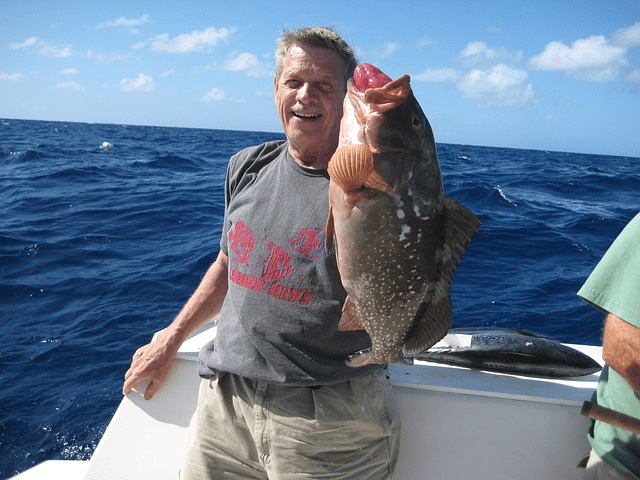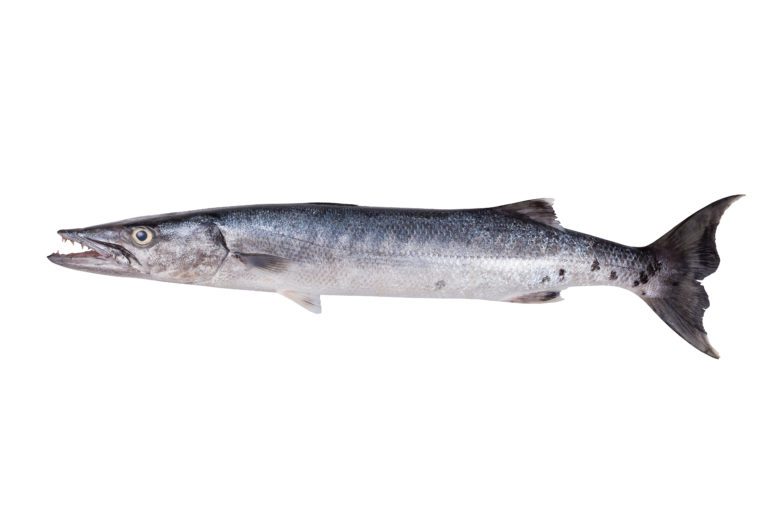Tarpon 101: The Ultimate Angler’s Guide to Understanding and Catching This Majestic Game Fish
What makes Tarpon a prized catch for anglers? Known for their impressive size and spirited strength, Tarpon offer an unmatched fishing challenge. This article dives into the world of Tarpon fishing, detailing the essential techniques, ideal locations, and key insights into the behavior of these remarkable fish. Learn what it takes to tackle the mighty ‘Silver King’ and understand the significance of conservation for preserving this species.
Key Takeaways
- Tarpon, known as ‘The Silver King,’ are large, powerful game fish that offer a serious challenge to anglers due to their acrobatic leaps and long fights when hooked — characteristics which invoke an adrenaline rush, rather than culinary pursuit, as their flesh isn’t commonly eaten.
- Tarpons have versatile habitats and diets, thriving in various water bodies and feeding on a wide range of prey, from fish to crustaceans. They have a unique method of suction feeding and can adapt their hunting techniques, making them formidable predators with complex social and migratory behaviors.
- Conservation is key to Tarpon fishing; the sport is regulated, and ethical catch-and-release practices are essential for species survival. Tarpon have significant cultural and historical value, while also contributing economically to regions where Tarpon fishing is popular.
Unveiling the Tarpon: Nature’s Silver Gladiator
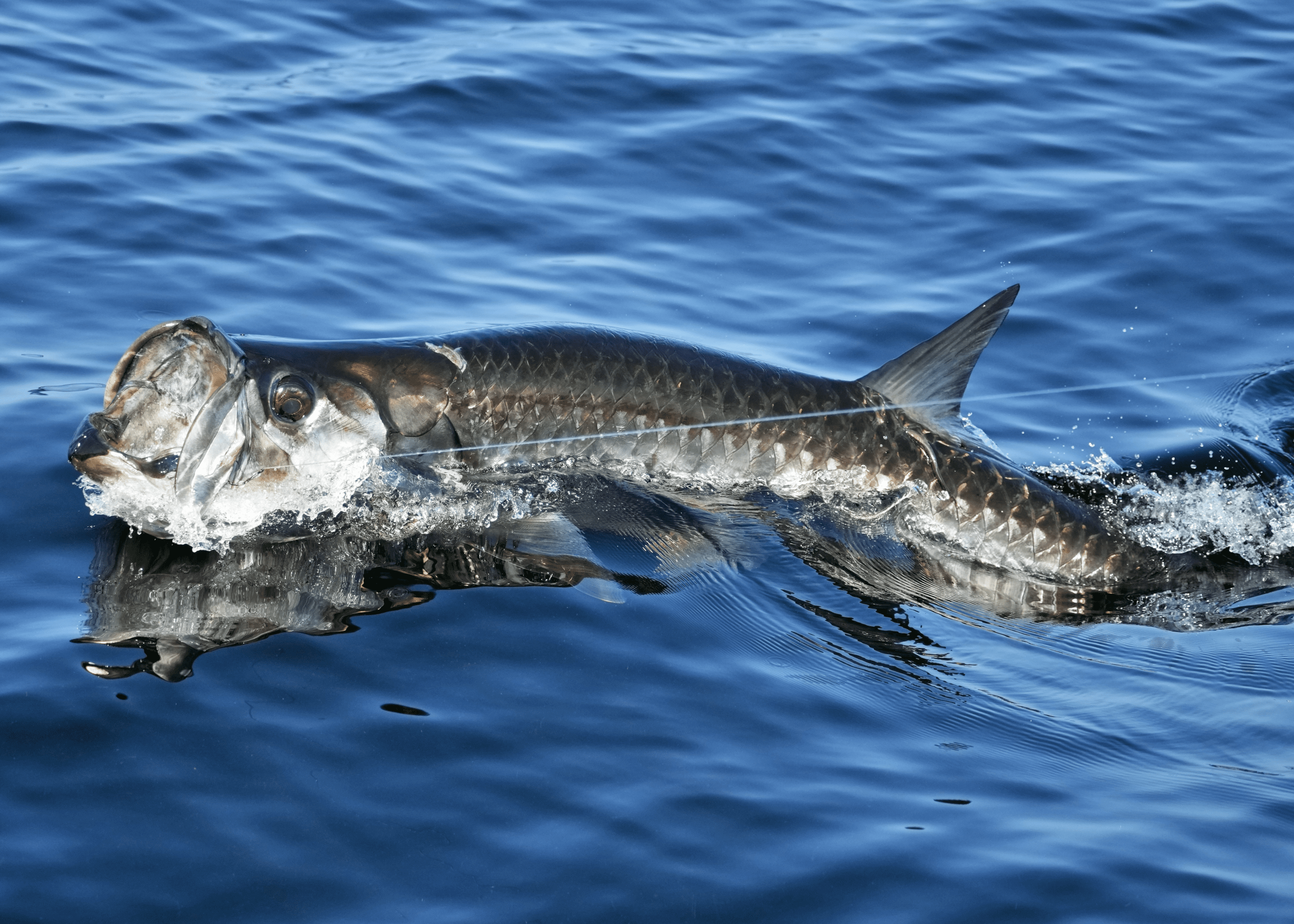
Celebrated as one of the most exhilarating catches in the sport fishing world, the Tarpon is a sight to behold. Towering over most game fish, a typical Tarpon weighs between 25 to 80 pounds, though the biggest ever caught tipped the scales at an astonishing 286 pounds. But it’s not just the size of the Tarpon that earns it the nickname ‘The Silver King.’ This fish is a certified gladiator of the seas, known for its battle-hardened endurance and spectacular aerial displays that leave anglers in awe.
Renowned for its acrobatic leaps and powerful runs, the Tarpon is a challenge that many sport fishers cannot resist. With its muscular build and prehistoric lineage, it’s no wonder that Tarpon fishing is a bucket-list experience for many. But it’s not about landing a delicious meal; instead, it’s the thrill of the fight that keeps anglers coming back for more. Anglers don’t fish for the Tarpon to eat it; rather, they seek the adrenaline rush that comes with every tug on the line.
So, are you ready to take on the Silver King in its natural arena? The challenge awaits!
Defining the Tarpon

Upon examining the Tarpon, we find a creature of sublime beauty, flawlessly suited to its surroundings. Its body is a stunning blend of silvery scales, with a dark blue to greenish-black color on its back that fades to a vibrant silver on its sides and belly. This metallic sheen has earned the Tarpon its regal nickname, ‘The Silver King.’ In certain lights, they may also appear brownish or brassy, but those unmistakable silver scales always shine through.
The Tarpon’s size is another distinguishing feature. Adult Tarpons can reach a staggering length of 8 feet and weigh between 200 and 300 pounds. The world record for the largest Tarpon ever landed belongs to a female Tarpon weighing 286 pounds, 9 ounces, caught in Rubane, Guinea-Bissau. With such impressive size, Tarpon fishing is not for the faint-hearted. It’s a game for the brave, the tenacious, and the adrenaline-seekers among us.
The Life Cycle of a Tarpon

The Tarpon’s life cycle holds as much fascination as its impressive size and strength. These fish are meticulous when it comes to reproduction, with spawning typically occurring in warm, secluded offshore areas. The timing of Tarpon spawning is largely influenced by the lunar cycle, with most spawning activity taking place around the time of a full moon or new moon. During this period, Tarpon migrate to their chosen spawning grounds, ensuring the survival of the next generation.
From their humble beginnings as transparent, ribbon-like larvae, Tarpon undergo a remarkable transformation as they grow. By the time they reach 6-7 years of age and about 4 feet in length, they are ready to reproduce. The females can grow quite large, with some reaching up to 300 pounds and over 8 feet long. But it’s not just their size and reproductive habits that are impressive; Tarpon can live for over 50 years, making them one of the longest-living fish species. This longevity, along with their ability to adapt to different environments, has allowed the Tarpon to thrive for millions of years.
Tarpon Habitats: From Freshwater Rivers to Coastal Waters
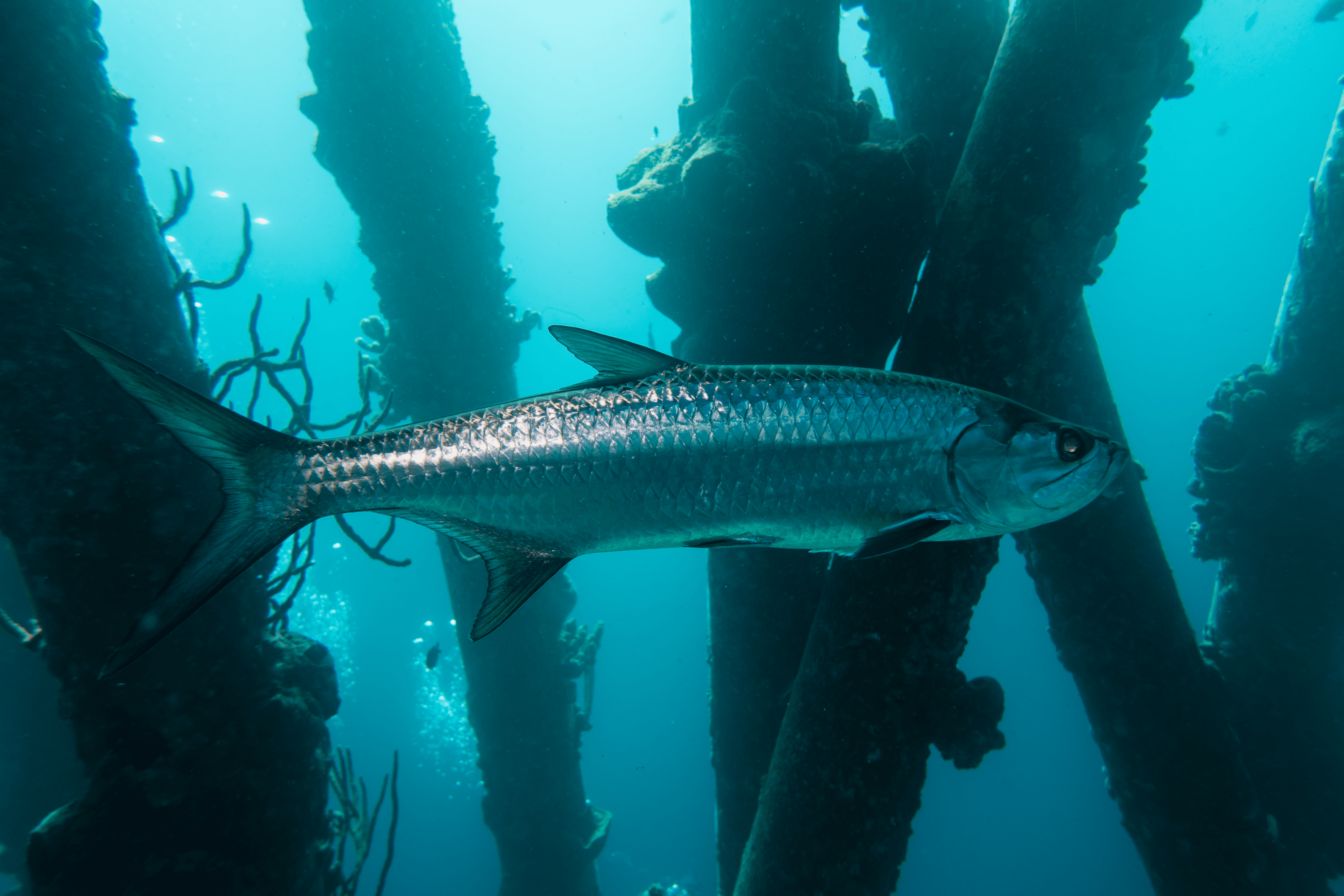
Tarpon inhabit a range of environments, showcasing their impressive adaptability. They can be found in:
- Coastal waters
- Bays
- Estuaries
- Mangrove-lined lagoons
- Freshwater rivers
- Landlocked canals
Particularly in South and Central Florida, near the Gulf of Mexico Florida, it’s common to spot medium-sized Tarpon making themselves at home in these unlikely environments.
A key to the Tarpon’s adaptability lies in its specialized swim bladder. This unique organ allows tarpon to:
- gulp air, enabling them to survive in waters with low oxygen content
- inhabit waters as deep as 98 feet
- move to warmer, deeper areas when the temperature drops
These survival tactics, combined with their impressive size and strength, contribute to the Tarpon’s reputation as a formidable game fish.
Tarpon Behavior and Diet: Understanding the Predator
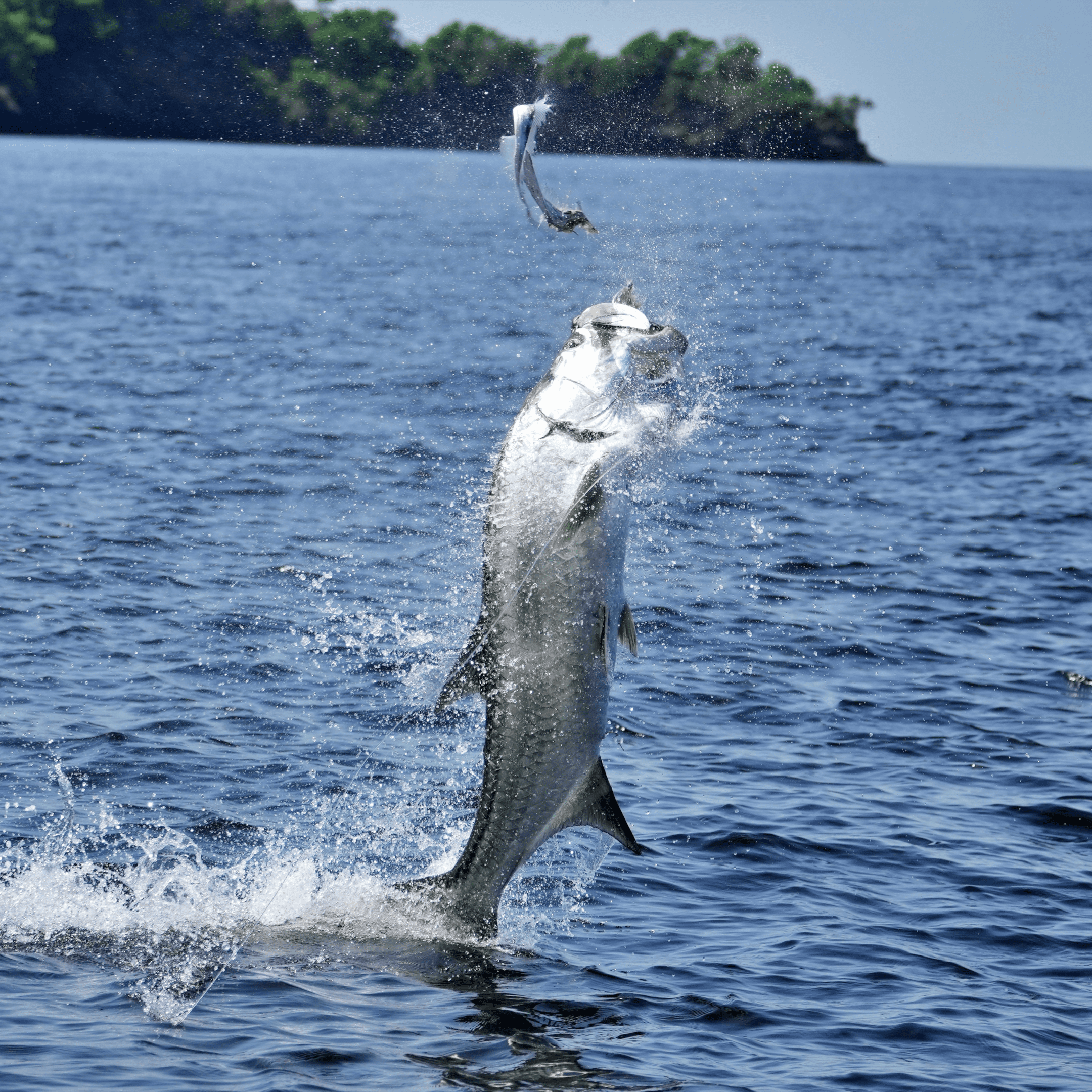
To truly appreciate the majesty of the Tarpon fish, one must understand its behavior and diet. Tarpon are voracious eaters, preying on a variety of creatures, including:
- mullets
- pinfish
- sardines
- larger crustaceans such as crabs and shrimp
While some may wonder if people eat Tarpon, it’s important to focus on the Tarpon’s own eating habits to better understand this fascinating species.
As juveniles, they start their diet with small crustaceans, worms, and small fish, but as they grow, their appetite expands to accommodate larger prey.
The Tarpon’s feeding strategy is as dynamic as its diet. These fish are well-equipped for hunting, using their powerful tail to chase and capture their prey at high speeds. Depending on their environment and the type of prey they’re after, Tarpon can switch up their hunting techniques, demonstrating their versatility as predators. Some of their hunting techniques include:
- Ambushing prey from below
- Chasing down prey in open water
- Feeding on schools of baitfish
- Hunting near the surface for insects or small birds
Their social behavior and migration patterns further illustrate the complexity of these creatures, but there’s still much to learn about how they interact within their groups and navigate their migratory routes.
What Does the Tarpon Prey On?
The Tarpon’s diverse diet mirrors its predatory nature. Adult Tarpons have a preference for fish, crabs, and shrimp, feeding on whatever is abundant in their environment. Some of their preferred meals include mullets, pinfish, marine catfishes, Atlantic needlefish, and sardines. With such a broad diet, tarpon are well-equipped to thrive in various habitats, from the western Atlantic coast to the eastern Atlantic regions.
The Tarpon’s diet evolves as it grows, starting with zooplankton during its juvenile tarpon phase, then graduating to:
- fish
- crabs
- shrimp
- occasionally worms
This varied diet, which includes larger prey like crabs and shrimp, is a testament to the Tarpon’s adaptability and its prowess as a predator.
The Unique Feeding Mechanism of Tarpon
The Tarpon’s feeding mechanism is as distinctive as the fish itself. Unlike many other species that nibble or bite their food, tarpon use a method known as suction feeding. This involves expanding their mouth rapidly to create a vacuum that sucks in water along with the prey. This efficient method of feeding allows Tarpon to capture their food quickly and effectively.
The Tarpon’s mouth plays a crucial role in its feeding process. The mouth is wide and capable of creating a strong suction force, while the gills flare out to allow water (and prey) to be swiftly sucked in. Despite their tiny teeth, tarpon can swallow their prey whole, showcasing their unique adaptations for survival in the wild.
Social Behavior and Migration Patterns
Tarpon display intricate social behaviors and migration patterns. They can be solitary or social, often traveling in schools during long-distance migrations. The reasons for their migrations are mostly driven by changes in temperature, food availability, and the urge to spawn. Understanding these patterns can provide valuable insights into the habits and survival strategies of this fascinating species.
The social dynamics within Tarpon groups are still a subject of ongoing research, with many fascinating aspects yet to be fully understood. However, it is clear that the way Tarpon interact within their groups and navigate their migrations plays a significant role in their survival. This highlights the importance of ongoing research and conservation efforts to preserve this incredible species for future generations.
The Thrill of Tarpon Fishing: Techniques and Hotspots

If you’re seeking the thrill of the chase and the exhilaration of a hard-fought battle, Tarpon fishing offers the ultimate adventure. This section will guide you through the art of Tarpon fishing, covering the essential gear, the best locations, and the ethical angling practices that ensure the survival of this magnificent species. Whether you’re a seasoned angler or a rookie looking to take on a new challenge, Tarpon fishing promises an unforgettable experience.
There’s no denying that Tarpon fishing is a sport that demands skill, patience, and respect for the fish. The fight that a Tarpon puts up when hooked is legendary, making it one of the most sought-after game fish among recreational anglers. But it’s not just about the thrill of the fight. Tarpon fishing also contributes to local economies, especially in areas like the Florida Keys, where the industry is worth millions. This economic impact underscores the importance of sustainable fishing practices and conservation efforts.
Gear Up for Tarpon: Rods, Reels, and Bait
Possessing the right gear is vital for successful Tarpon fishing. Your rod and reel setup can make all the difference between landing a Tarpon and watching it slip away. For Tarpon fishing, you’d want a rod that’s around 8 feet long for better casting and control. The rod should have a heavy power rating and a fast-action for a more versatile presentation.
Choosing the right reel and bait is equally important. A top-notch drag system is essential to handle the power of a Tarpon. Depending on the size of the Tarpon you’re targeting, the weight of your reel will vary. For small or juvenile Tarpon, a reel weighing 8 to 10 is ideal, while a weight of 12 is suitable for bigger migratory Tarpon.
When it comes to bait, live options like mullet, shrimp, pinfish, and crabs are highly effective, attracting Tarpon with their natural movements and scents.
Prime Locations for Tarpon Fishing

Identifying the optimal fishing spot is a vital aspect of Tarpon fishing. Some of the top spots for Tarpon fishing include:
- The Florida Keys
- Miami
- Boca Grande near Fort Myers
- Areas from Tampa Bay to Tarpon Springs and Crystal River, which offer some of the most Tarpon fishing opportunities.
These locations offer prime Tarpon habitats, increasing your chances of landing a big one.
In Miami, drifting inlets during the peak season, from November to June, is a popular technique for fishing near the warmer coastal waters of the Atlantic Ocean and the Gulf of Mexico. The bait of choice often depends on the tarpon’s mood, adding an element of unpredictability to the challenge.
On the other hand, in Tampa Bay, migratory Tarpon can be found almost all year round, and eat baits like:
- Various types of crabs
- Menhaden
- Pilchards
- Pinfish
- Threadfin Shad
For those seeking a tropical adventure, San Juan, Puerto Rico, is another renowned Tarpon fishing destination, promising both thrilling Tarpon encounters and beautiful scenery.
Catch and Release Fishery: Ethical Angling Practices
Like all fishing, ethical and sustainable practices are vital in Tarpon fishing. The practice of catch-and-release plays a crucial role in conserving tarpon populations, allowing these fish to continue their life cycle and reproduce. By releasing Tarpon after they’ve been caught, anglers can enjoy the thrill of the chase without negatively impacting the Tarpon population.
Releasing a Tarpon safely involves:
- Keeping the Tarpon in the water at all times (this is rule for Tarpon over 40″)
- Carefully removing the hook or cutting the leader close to the hook
- Minimizing handling the fish to preserve its protective slime layer
- Keeping the rod tip low or in the water when releasing the Tarpon
Studies have shown that with proper handling, the majority of released Tarpon survive, contributing to conservation efforts and the continued opportunity for anglers to experience the thrill of Tarpon fishing.
Conservation and Regulations: Protecting the Future of Tarpon
Despite being revered for their size and strength, Tarpon confront substantial threats to their survival. From habitat loss to overfishing, these factors have led to declining Tarpon populations, making conservation efforts more important than ever. In this section, we’ll explore the current state of Tarpon populations and the regulations in place to protect this incredible species.
Due to the popularity of Tarpon fishing, regulations are in place to manage the sport and secure the species’ survival. These regulations include special permits for Tarpon fishing and rules around catch and release practices. By understanding and following these regulations, anglers can contribute to the conservation of Tarpon and ensure that future generations have the chance to experience the excitement of catching ‘The Silver King’.
The Plight of the Tarpon Population
The dwindling Tarpon populations pose a major worry to those passionate about these majestic creatures. Overfishing, in particular, has had a considerable impact on Tarpon numbers, altering their behavior and disrupting ecosystems. Exploitation of Tarpon outside the US is a major contributor to their decreasing numbers.
Habitat loss is another critical factor affecting Tarpon populations. Factors such as deteriorating water quality, habitat destruction, and the construction of dams have all contributed to the loss of vital Tarpon habitats. With less habitat area available, the growth of the Tarpon population is limited, further exacerbating their decline.
Regulatory Measures for Tarpon Fishing
A range of regulations oversee Tarpon fishing to guarantee the sport’s sustainability. Tarpon are a catch-and-release only species. Additionally, the bonefish tournament exemption permit has been abolished, reinforcing the focus on catch and release practices.
The Tarpon tag is a key regulatory measure used to manage Tarpon fishing. This tag is used by anglers who wish to catch and kill Tarpon for record-keeping purposes and to contribute to research at the Florida Marine Research Institute.
The Role of Anglers in Tarpon Conservation
Anglers can help to conserve the populations of Tarpon by:
- Adopting sustainable fishing practices
- Protecting habitats
- Supporting research initiatives that aim to better understand Tarpon behavior and survival strategies
By doing so, anglers can play a significant role in the preservation of Tarpon populations and contribute to more effective conservation efforts.
Organizations like the Bonefish & Tarpon Trust (BTT) offer opportunities for anglers to get involved in conservation efforts. Through funding and conducting projects that provide critical information for conservation, BTT has achieved tangible conservation outcomes. By collaborating with anglers, the industry, and researchers, the organization is reshaping conservation efforts to ensure the survival of Tarpon for generations to come.
Tarpon Through the Ages: A Journey Through History
The Tarpon’s history is as enthralling as the creature itself. From its prehistoric origins to its cultural significance around the world, the Tarpon has left an indelible mark on human history. In this section, we’ll journey back in time to explore the origins of this remarkable fish and its impact on human culture.
Tarpon have played an important role in many cultures, revered for their strength and resilience. Indigenous tribes considered the catching of a Tarpon a significant achievement, while in Tarpon Springs, Florida, the Tarpon is an integral part of the culture. From art to folklore, the Tarpon has influenced human culture in myriad ways, showcasing its enduring significance throughout the ages.
Tarpon History: A Prehistoric Fish with a Story
With origins stretching back over 125 million years to the Miocene period, the Tarpon has a long history. Fossil evidence, including vertebrae resembling those of sharks, attests to the Tarpon’s prehistoric roots and its remarkable survival through the ages. From those ancient times to the present, the Tarpon has evolved and adapted to survive in a range of environments, from the open ocean to freshwater rivers.
Over millions of years, the Tarpon has evolved unique features and survival strategies that have enabled it to thrive. From its early leptocephalus phase, which evolved around 18 million years ago, to its ability to survive in various water environments, the Tarpon’s history is a testament to its resilience. This incredible survival story is a reminder of why conservation efforts are so crucial to preserving this prehistoric fish for future generations.
Cultural and Economic Impact of Tarpon
In regions where they thrive, Tarpon have had a profound impact on human culture and economies. In many societies, Tarpon are seen as symbols of power, strength, and resilience. They have been featured in Tlingit art, swimming alongside other important animals, and are tied to ancient legends and spirituality. In Tarpon Springs, Florida, the city celebrates the Tarpon with various events, including Arts & Crafts Festivals and outdoor dining experiences with Greek music and dancing.
Apart from its cultural significance, Tarpon fishing also contributes to local economies. The industry is particularly important in Southwest Florida, where it’s estimated to have an economic impact of around $19 million in regions like the St. Lucie River and Estuary. This economic contribution underscores the importance of sustainable fishing practices and conservation efforts to maintain the local Tarpon populations and the industries they support.
Summary
From its prehistoric origins to its role in modern sport fishing, the Tarpon’s story is one of resilience and adaptability. As one of the oldest living fish species, the Tarpon has survived through changing environments and human pressures. As anglers, we have the responsibility to respect and protect this incredible species, ensuring its survival for future generations. Whether you’re an experienced angler or new to the sport, the Tarpon offers a thrilling challenge and a connection to the ancient world that few other species can. So gear up, respect the regulations, and experience the thrill of Tarpon fishing!
Frequently Asked Questions
Is Tarpon a good fish to eat?
Tarpon is edible, but it’s not commonly eaten due to its bony meat and unappealing taste. It’s better to opt for other fish like a Red Snapper.
Why are you not allowed to keep tarpon?
You can’t keep or even lift a Tarpon of a certain size out of the water in Florida and other states, as it could cause injury to the fish. It’s important to protect their well-being when fishing.
How old is a 100 pound Tarpon?
A 100 pound Tarpon is typically around 13-16 years old.
Are Tarpon hard to catch?
Yes, Tarpon are hard to catch due to their acrobatic nature and the skill required to hook them. They are considered a challenging and popular bucket list fish.
What kind of environments do Tarpon inhabit?
Tarpon can be found in a range of habitats, such as coastal waters, estuaries, mangrove-lined lagoons, and even freshwater rivers and canals. They are very adaptable and can thrive in diverse environments that other fish could not.




